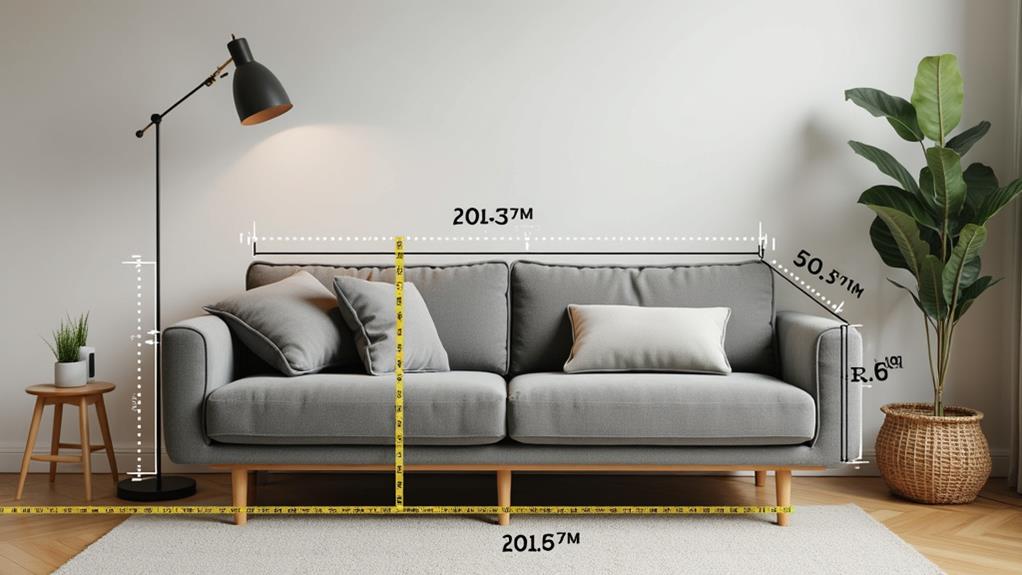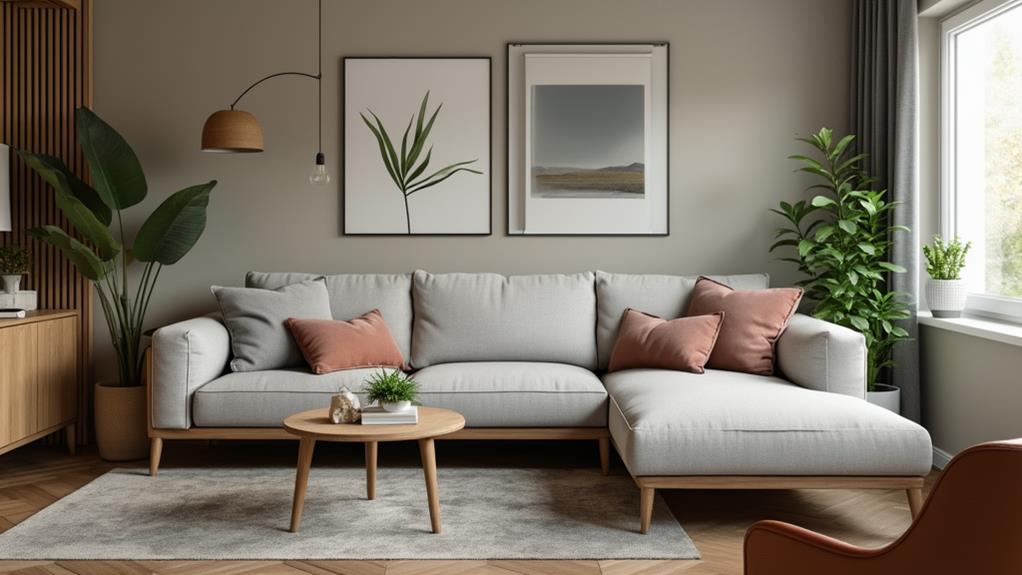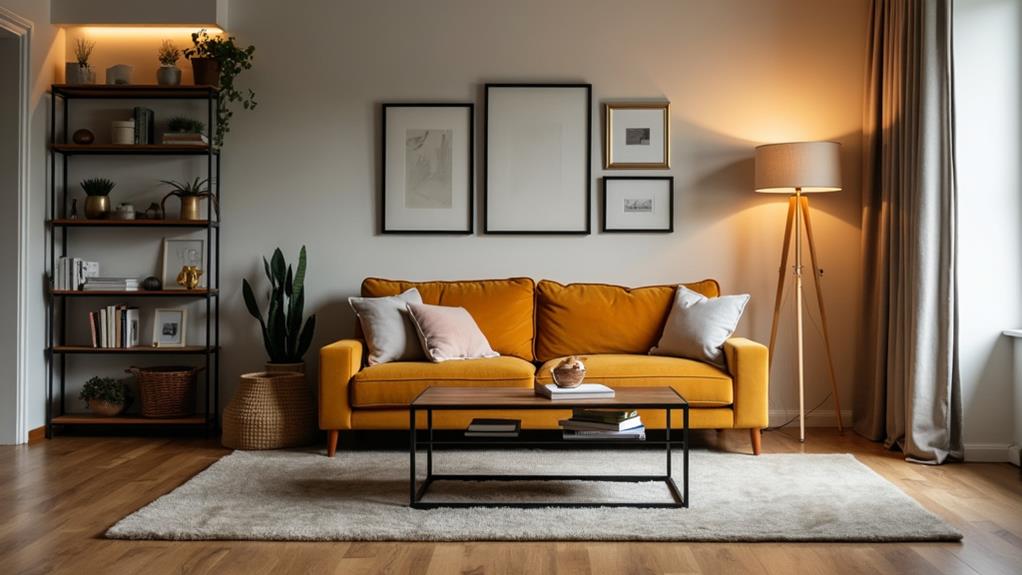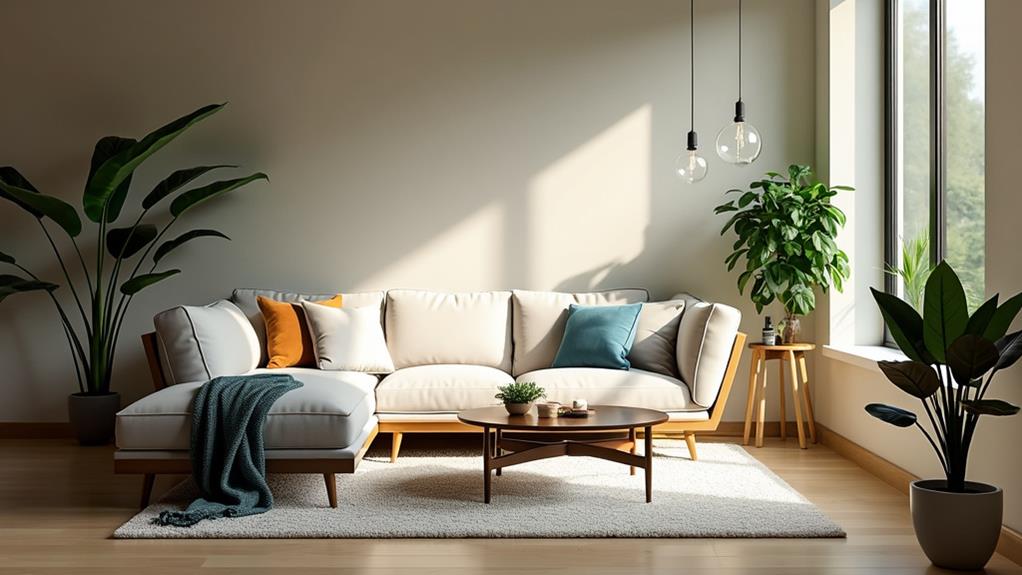Mastering the art of small-space sofa selection involves balancing dimensions, style, and functionality for an optimized living area. We need to measure our room accurately, considering length, width, and height, and account for architectural elements like windows and doors. Ideal sofa sizes range from 72 to 84 inches in length and 32 to 36 inches in depth, providing comfort without overcrowding the space. Opt for sleek designs with raised legs to enhance visual openness and integrate multifunctional styles like sofa beds. Ensuring other furniture pieces complement the sofa's size and placement is essential to maintain traffic flow and harmony. These steps will lead to smarter sofa choices.
Understanding Sofa Dimensions

When choosing a sofa for a small space, understanding its dimensions is essential. We need to take into account the length, depth, and height of the sofa to guarantee it fits comfortably within the room. A sofa that's too large can overwhelm the area, while one that's too small mightn't provide the necessary seating.
As a result, we should start by looking at the overall length of the sofa, which usually ranges between 70 to 96 inches. For compact spaces, opting for a sofa around 70 to 80 inches can be ideal.
Next, we must examine the depth of the sofa. Standard depths vary from 32 to 40 inches. In a smaller room, a depth of around 32 to 34 inches can help maintain an open feel without sacrificing comfort.
The height of the sofa, including the backrest and legs, also plays a role. Lower backrests around 30 inches can make the room appear more spacious, while higher backrests may feel more constricting.
Additionally, taking into account the armrest design and cushion thickness can impact the overall footprint of the sofa. By understanding these dimensions, we can make informed decisions that enhance both functionality and aesthetics in our small space.
Assessing Your Space
Evaluating the available space in your room is crucial for selecting the perfect sofa. We need to start by measuring the dimensions of the room, noting the length, width, and height.
It's important to take into account any architectural features such as windows, doors, and radiators that could influence the placement of the sofa. If there are any built-in elements like shelves or fireplaces, we should also measure their locations and sizes. Additionally, reflect on any existing storage solutions that may impact the room's layout.
Once we've our measurements, let's create a floor plan. This can be done on graph paper or using a digital tool. By drawing a scale model of the room, we'll be able to visualize different sofa placements and identify potential layout challenges.
It's crucial to think about traffic flow; we should confirm that the sofa doesn't obstruct pathways and allows for easy movement throughout the room.
Next, we should ponder how the room is used. Is it primarily for relaxation, entertaining guests, or perhaps both? Understanding the purpose of the space will help us determine the best spot for the sofa.
Ideal Sofa Size

Now that we've thoroughly assessed our space and created a detailed floor plan, let's focus on selecting the ideal sofa size. The first step is understanding the dimensions of our room and how much space we can allocate to the sofa without compromising the flow and functionality of the area.
We should consider not only the length and width of the sofa but also its depth and height, guaranteeing it complements the scale of our space. Typically, for small spaces, a sofa that's between 72 to 84 inches in length is best. This size allows for adequate seating without overwhelming the room.
Additionally, a depth of 32 to 36 inches is preferable, providing comfort without encroaching too far into our limited space. It's also essential to leave at least 18 inches of walking space around the sofa to facilitate easy movement.
We should also account for other furniture in the room and make sure our sofa size harmonizes with them, creating a balanced and cohesive look. By meticulously measuring and considering our room's layout, we can select a sofa that maximizes comfort and style while maintaining the room's functionality.
Sofa Shapes and Styles
Choosing the right sofa shape and style is crucial in creating a comfortable and visually appealing small space. When considering shapes, we should think about how they fit into our room's layout. L-shaped sofas, for instance, can be efficient space-savers, tucking neatly into corners and providing ample seating without overwhelming the room.
On the other hand, a loveseat or a settee might be more appropriate for extremely compact areas, offering seating without excessive bulk. For those looking to add a touch of elegance, pieces like a French Style Deep Button Chair can also serve as accent seating in small spaces.
In terms of styles, sleek and modern designs often work best in small spaces. Sofas with clean lines and minimalistic features help avoid visual clutter, giving the room a more open and airy feel. Similarly, selecting a sofa with raised legs can create the illusion of more space by allowing light to pass underneath it.
Upholstery choices also play a critical role; lighter colors and simpler patterns can make the room appear larger and more inviting.
Additionally, multifunctional sofas, such as sofa beds or those with built-in storage, can greatly enhance the utility of a small space. By carefully considering both shape and style, we can guarantee our sofa not only fits but also enhances our living area.
Factoring Other Furniture

While selecting the perfect sofa shape and style sets the foundation for a well-designed small space, it's equally important to thoughtfully arrange the other furniture pieces to maintain balance and functionality. We must consider the relationship between the sofa and its accompanying elements, guaranteeing they complement rather than compete with one another. This involves a careful evaluation of the dimensions, placement, and utility of each item in the room.
To aid in visualizing how different pieces work together, here's a table that outlines essential considerations for integrating other furniture with our chosen sofa:
| Furniture Piece | Considerations | Tips for Integration |
|---|---|---|
| Coffee Table | Height and width relative to the sofa | Choose a table that's proportionate |
| Side Tables | Ease of access and space efficiency | Opt for narrow or multi-functional tables |
| TV Stand | Viewing distance and eye level | Guarantee it's aligned with seating height |
| Bookshelves | Storage needs and visual balance | Place them to create symmetry or interest |
| Chairs & Ottomans | Additional seating and flexibility | Use lightweight or movable options |
Tips for Sofa Placement
When it comes to placing a sofa in a small space, strategic positioning can make a world of difference. First, we should consider the room's focal point, whether it's a window, a fireplace, or a television. Placing the sofa to face or complement this feature can create a natural flow and enhance the room's overall aesthetic.
Additionally, positioning the sofa against a wall can maximize open space and make the room feel less cluttered.
Next, let's think about the traffic flow. We want to guarantee that people can move around the room without obstruction, so placing the sofa in a way that doesn't block pathways is essential.
In some cases, angling the sofa or using an L-shaped configuration can help in making the most of corners and awkward spaces.

